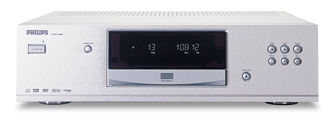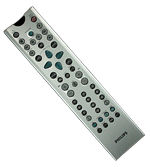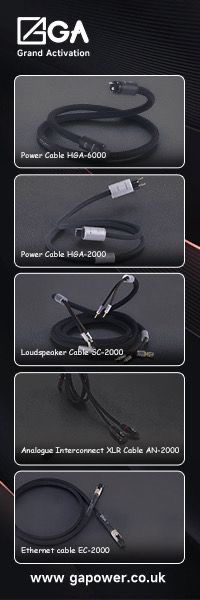APL Hi-Fi Philips SACD1000 Modification
| APL Hi-Fi Philips SACD1000 Modification
|
|
Todd Mitchell, April 2004 |

CES 2004 was a warm and fuzzy event for HDTV aficionados. After years of roadblocks, delays, stops, and starts, the transition from analog NTSC to digital HDTV finally seems to be on track. Cable systems have now been rebuilt and, in most parts of the country, have more than a modest smattering of HD content to choose from. On April 1st, the FCC ratified the Plug and Play Agreement between cable and consumer electronics manufacturers, which will take effect. As a result, your cable company will be required to supply a FireWire ported STB on demand, enabling full-resolution recording of HDTV content to D-VHS videotape. Cable is now effectively competing with satellite providers in the HDTV realm, and a wealth of new content has arrived or will be coming soon.
The picture for high resolution audio (HiRez) is a bit more murky. Despite the Home Theater phenomenon, Home Audio stands out as the single negative growth sector in all of consumer electronics. After years of bemoaning the shortcomings of the Redbook CD, the High End Audio press seems to be lukewarm to the competing DVD-A and SACD formats. The RIAA seems much more interested in prosecuting downloaders of low-fi MP3 than promoting HiRez. While audiophile labels are embracing HiRez, one still cannot count on any new release from the majors to be made available in either of the new formats. Even as Universal players are now at last becoming ubiquitous and inexpensive, few are targeted for quality at a reasonable price point. There seemed to be almost a backlash of sorts in the audiophile-targeted rooms of the St Tropez and Alexis Park, where SACD-capable players predominated, but for most, utilized only Redbook recordings.
Granted, demonstrating the superiority of audio formats is a much more subtle piece of business than for video. Show consumers a live football game or even a movie in NTSC vs. HDTV on a reasonably decent monitor, and they are not hard-pressed to see the vast advantage HD presents. It is, of course, much different for audio, where a system must be up to task to fully take advantage of the vastly higher density of information contained on a 96/24 or SACD disc.
One such room at the St Tropez heralded the return of the highly regarded ESP Loudspeaker. Rave reviews of the room have been posted on many websites, including ours. The source component utilized was a rather nondescript, long-discontinued Phillips SACD 1000, modified by one Alexander Peychev of APL HiFi. A small sign in black marker perched atop the player declared it to be playing only redbook CDs. But the sound itself: Mamma Mia, it was so smooth and warm and detailed. How good was that sound? Well, our fine editor set up camp, shut down the lights, and held sway on the remote controls for over an hour while an angry mob gathered outside the door demanding to get in and find out just what the fuss was all about.

The Phillips SACD 1000 has earned a certain notoriety unmatched by any other source component of recent memory. Overbuilt to the nines, it was considered a steal of sorts when it first released at a list price of ~ $2K a few years ago. It was, after all, the first multichannel SACD player and incorporated virtually all of the high-end componentry of the Marantz SA-14. Marantz themselves also issued the SA-12S1 which differed only in its cosmetics, listing at a cool $3800. The SACD1000 earned superlative reviews (check out the archives at hifichoice.co.uk, audioholic.com, and stereophile.com) for its staggeringly low jitter measurements and warm musical sound that many preferred to the first generation of high-end Sonys. Unfortunately, the failure rate of the Phillips was also remarkably high, and most disturbingly, Phillips could not seem to figure out how to fix them. As the grumbling mounted and Phillips attempted to mollify customers by offering free replacements with its much cheaper second-generation models, the player was quietly discontinued, and ultimately, remaining stocks were sold off in a Tweeter’s fire sale for ~ $399 last year.
Finally, through the well-documented efforts of a heretofore unknown modder named Alex Peychev and a renegade Phillips engineer in Tampa named Jim Luckas, the root of the problems was finally determined to be failing Fuore and Mace chips, which were corrupting the data and rendering the players useless. Once the problems were finally identified in late 2003, Phillips was slow to manufacture and release the new chipsets necessary for the repair.
Despite the increasingly precious nature of working SACD1000s, Peychev, for several months, listed the SACD1000 as his only platform for source modification. Why the SACD1000, you ask? According to Alex, this unit has many characteristics that, when combined as a whole, make it an ideal platform for modification. First, the SACD1000 used a superior transport. This transport is also the basis of the highly regarded Krell SACD Standard and other high-end models. The SACD1000 also utilizes a hefty DSP RAM buffer for both Redbook and SACD audio, which results in vanishingly low jitter. Finally, the SACD1000 used the very highly regarded Crystal 4397 DAC for its D-A stage, one per channel. This SACD and 192/24 capable DAC has also been used to great acclaim by Perpetual Technologies and is the heart of the $12K Classe Omega SACD player. But the best attribute of the SACD1000 from both a modder’s and a customer’s perspective is the cost. Especially at its blowout price of $399 bucks, but even at current second-hand market prices of more than twice that, the SACD1000 is a genuine steal. And who gives a hoot about the warranty when it is already well known that Alex is probably one of only two or three individuals in all of North America who knows how to troubleshoot and fix the bugger, which he will do for free if it is one of his modded units.
So whaada get for the $1850 cost of modification? Alex’s website (aplhifi.com) describes upgrades to the power supply, point-to-point silver wiring, power supply upgrades, transformer upgrades, and a superclock. Most impressive is the transformer-coupled single-ended triode class A tube stage that Alex has adapted from the hybrid solid-state-tube preamps and amplifiers he has built. He uses a “Super Linear 6H30pi Super Triode Dual Triode,” which is described as the bleeding edge of the vacuum tube industry. He also adds two more Crystal 4397 DACs to the mix, thus four DACs per channel. (Did I forget to mention that this mod is aimed squarely at state-of-the-art two-channel? If you still want multichannel, Alex can accommodate that too.)
Mod-shmod; how does it sound? Simply heavenly! With SACDs and 96/24 DADs like those from Classic Records and AIX Records, the modded SACD1000 delivers a sound that delivers a visceral pleasure that may be illegal in some Southern States. Really, I kid you not, that the experience of listening to HiRez recordings on this box is an absolutely transformative experience. But even on the Redbook CD, the sound is completely devoid of the nasties we usually associate with digital. Warm, detailed, fleshy bass, and yet laid back and relaxed in an uncanny manner.
Others have favorably compared it to the $9K plus Goldmund and other megabuck SACD players, including modified versions of the venerable Sony SCD-1. I haven’t heard all of those, but I have spent a good deal of time with Ed Meitner’s DAC 6. Ironically enough, a modified Phillips SACD1000 is also used in that system, but only as a transport. To the SACD1000, Meitner adds a digital output board using dual ST glass links, which allow the clock in the DAC 6 to act as master and the transport as slave (Am I the only one who gets excited at these S&M references?) Many regard Meitner as absolutely the state of the art, and most SACD recordings were actually mastered using Ed’s equipment. One highly respected reviewer has proclaimed the Meitner to be the best DAC available for Redbook CD, besting both the dCS Elgar and Linn CD-12. Who am I to disagree? I had the Elgar and Purcell, and yes, the Meitner runs rings around them. The Meitner makes everything you feed it sound incredibly good, even PCM converted Dolby Digital movie soundtracks and satellite delivered FM. A favorite source of new jazz to my ears comes from the syndicated programming provided by the legendary former KJAZ record spinner Bob Parlocha. The Meitner simply puts the best possible spin on even digitally compressed sources and transforms them into music. The better the source, the better the experience, of course.
One advantage of the APL SACD1000 is that it can play both 96/24 DADs and SACDs. The ability to do so as well was lost in the process of transforming the SACD1000 into a Meitner transport. You will need a separate DVD player with a 96/24 digital output to play your DADs if you are using the Meitner DAC.
Side by side, the APL SACD 1000 gives up very little to the Meitner, especially as one ascends the food chain into hi-rez realms. Listening to DADs and SACDs is every bit as magical as when using the Meitner. The Meitner is more dynamic; the APL SACD1000 is warmer. Both are detailed in spades and deliver the goods in a manner that will finally have the honest vinyl lover admitting in his heart of hearts that maybe it will be all okay after all. Unfortunately, the APL SACD1000 has no digital input board, at least not yet. Upsampling of Redbook to 192/24 may be in the works, however. Knowing just how obsessed Alex is with producing the very best sound possible at any cost, it is truly remarkable to me that he has accomplished his goal of equaling the musical satisfaction produced by the Meitner at a mere fraction of the cost (A Meitner mod to an SACD1000 is >$1K and the DAC6 costs ~ $10K. Using the soon to be released Meitner Transport will make for a much more expensive proposition.).
The audio quality of the APL SACD1000 ranks right up there with the very best digital source components. At its price of $1850 for the mod (you supply the stock unit), it is an incredible high-end bargain. But there is a catch: SACD1000s are now very hard to come by! Even the Meitner folks have seen their DAC6 sales suffer from the shortage of SACD1000s, as it is the only rig they modify for transport. Used SACD1000s have an exceedingly short half-life on Audiogon, and prices on the second-hand market have now more than doubled from last year’s Tweeters blowout. If you need one, contact Alex via the www.aplhifi.com website, and he can help you search.
It must be hard to build a business on the basis of modifying an extremely scarce and discontinued model. For those of you still intrigued but without the cash or patience to hunt down a stock SACD1000, Alex does provide an alternative. For a mere $695, Alex can provide you with a modified Pioneer DV-563A-s Universal player containing many of the goodies found in the modded SACD1000. Despite its sub-$200 price and diminutive size, the Pioneer actually contains both a quality transport and a reasonably good DSP RAM buffer. No Crystal 4397s and no tube output stage, but on the other hand your $695 does include both the mod and the player itself. We’ll give it a listen and report back soon.
So, how much better is HiRez than Redbook? Again, a visual analogy is instructive. Think of the Redbook CD as akin to DVD video. In this analogy, HiRez would be HDTV- a format that is ~ 4-6 times more data-intensive for any given content than DVD. The proof is in the pudding and is easy for all to see. Audio is a more subtle realm, but given a source equal to the task like the Meitner or APL SACD1000 and a capable playback system there can be no doubts left that we are entering into an era of home music reproduction that will finally match the hype we readers of the audiophile press have been striving for all these years.
Second that Emotion: Clement Perry
Hey, Todd Mitchell’s review of Alex Paychev’s modded unit is a modest one. The story I experienced from this super Audio CD player has been nothing short of revelatory. You all know that when I reviewed the Electrocompaniet EMC1, I felt its upsampling capabilities exceeded, if not equaled, that of the best SACD material the Sony SCD1 could muster. This proved depressing and changed my feelings for SACD from that day forward. Unit now.
The modded Philips unit is, shall we say, SACD sound on steroids. It so betters the Sony SCD1 that I would venture to say DON’T go out and buy anything that is a first of its kind. And if you are prepared to find that in time, it will be superseded by something vastly superior at less than half the price. The Philips, modded of course, is living proof of this fact in my humble estimation.
Without going too steep into comparisons I would state that this Philips player, which by the way, does not output 16/44 via SPDIF, therefore precludes its use a transport, will on some SACD’s sound unlike anything I’ve heard before analogue or digital via the Electro or even the mightily impressive Gryphon Mikado. The John Pizzarelli Live at Birdland disc [Telarc 2SACD-63577] is possibly the best illustration of this claim. When run through ancillary equipment such as the George Mark Audio dac/preamp, and the wonderfully musical deHavilland 845-G tube amp, I got to tell you that it is quite as exciting, if not more so, than my big rig upstairs with tons of tweaks and assorted room taming devices. That’s how good SACD can sound when properly realized via the properly recorded material.
Don’t Shoot the Messenger
There is a downside to this outstanding player, but you really can’t blame it. Any SACD from, let’s say, Sony’s vast vault of reissues of Miles Davis is at best disappointing. So much so that when going from something like the John Pizzarelli to the Miles, it’s like going from HDTV to VHS. And that’s no exaggeration. The noise and bite comes back instantly when I attempted to listen to Miles blow through his muted Harmon. I had to double-check, no, make that triple-check, the settings on the Philips to be sure I wasn’t back to 16/44 Redbook. Then I remembered that Sony doesn’t even offer hybrid discs that I am aware of to date. What a ripoff.
So, what one gets in a player of this magnitude is a very good to excellent DVD Player, which gets to be even better at Red Book 16/44 CDs. But once engaged to SACD programming via excellently recorded material, be prepared to hear something that may very well challenge much more expensive and highly touted DSD combos. One thing I am certain of after listening to this remarkable machine is that its only real competition is SACD’s varied recording process.
Finally, I understand what all the fuss is about. Alex Paychev has a dandy of a player in his modified player. If you can find one, you owe it to yourself to purchase it and send it directly to Alex for this extensive mod. To think of its sonic potential at less than $2500 makes it a downright steal.
| Specifications
APL Hi-Fi Philips SACD1000 Modification |
| Address: APL Hi-Fi 7000 Village Parkway Suite I Dublin, CA 94568 Telephone: (925) 560-9955 Website: www.aplhifi.com Email: info@aplhi.com |
![]()
Stereo Times Masthead
Publisher/Founder
Clement Perry
Editor
Dave Thomas
Senior Editors
Frank Alles, Mike Girardi, Russell Lichter, Terry London, Moreno Mitchell, Paul Szabady, Bill Wells, Mike Wright, and Stephen Yan,
Current Contributors
David Abramson, Tim Barrall, Dave Allison, Ron Cook, Lewis Dardick, John Hoffman, Dan Secula, Don Shaulis, Greg Simmons, Eric Teh, Greg Voth, Richard Willie, Ed Van Winkle, Rob Dockery, Richard Doron, and Daveed Turek
Site Management Clement Perry
Ad Designer: Martin Perry





Be the first to comment on: APL Hi-Fi Philips SACD1000 Modification